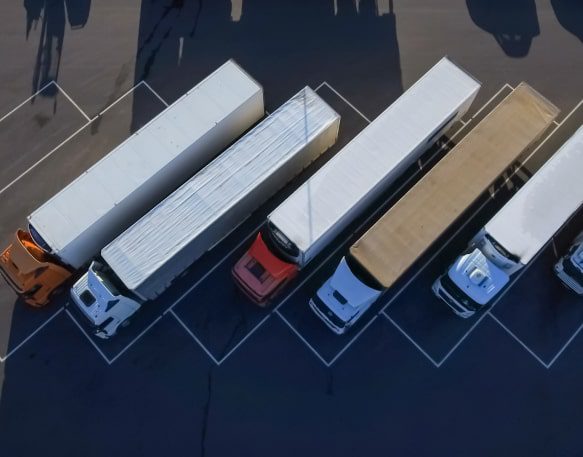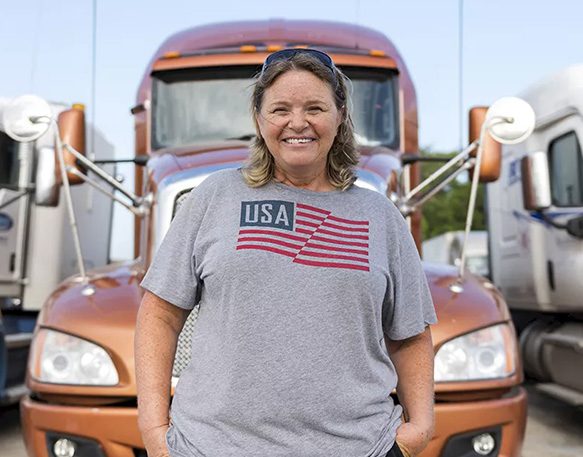In the wake of the global pandemic, supply chain disruptions, and tense geopolitical conditions, Americans are seeing record fuel prices and inflation rates. Trends like these are changing the trucking industry — perhaps for the better. Amidst all the uncertainty, many wonder if the trucking industry is growing, and the answer is a resounding yes! As consumer behavior continues to shift, having a strong trucking infrastructure is more critical than ever.
Much like the hospitality and construction industries, the trucking industry has had to reevaluate standard practices due to the major shifts brought out by the pandemic. From the incorporation of technology on the road, to how companies recruit new talent, the trucking industry is not only growing, it’s changing, too.
Let’s explore what the landscape of the trucking industry looks like, where it’s going, and how you can find success in this growing industry.
How big is the trucking industry?
How much is the trucking industry worth? In a comprehensive report from Market Research Future, the market worth of freight trucking is estimated to reach a staggering $4,032 billion by 2026. The data suggest that the distribution industry isn’t slowing down anytime soon. In their U.S. freight transportation forecast, ATA estimates total freight tonnage will grow from an estimated 15.1 billion tons in 2021 to 19.3 billion tons by 2032. That’s a 28 percent increase, creating substantial room for those in the trucking industry to expand their services and offering plenty of opportunities to secure a new position for those looking to join the industry for the first time.
Trucking in a post-pandemic world
It’s no secret that the pandemic drastically changed the world and continues to alter the shape of how we live and work. The logistics and distribution industries took a massive hit at the start of the pandemic when the world came to a halt. Now, as things slowly creep to a new normal, carriers, brokers, and shippers have to pivot and re-evaluate how to manage the continuous shifts in the supply chain.
The problem is that as people across the globe continue to increase their demand for products, companies are struggling to meet market needs for numerous reasons. Many of the vulnerabilities within the trucking industry have existed for years but were exacerbated by the global pandemic.
Addressing driver turnover
One of the most significant issues facing the trucking industry is driver turnover. COVID-19 and harsh economic factors make maintaining authority or even just being part of a fleet a challenge, if carriers and truckers aren’t prepared. This can cause drivers to look for opportunities elsewhere.
Over the next decade, ATA estimates that the industry will need to hire nearly a million new drivers to keep up with industry growth and offset the vast number of retirements and voluntary or involuntary leaves. As the industry looks for ways to change how they retain workers, those currently in or looking to join the industry can expect to see some of these quality of life improvements and incentives:
- Increase in pay or switching pay models, such as moving to hourly pay rates/
- Bonus programs, such as safety and retention bonuses
- Better benefits such as health insurance and paid leave
- Improvements to the culture
- Development opportunities such as companies paying for drivers to get their CDL and apprenticeships with veteran drivers
- Greater encouragement of diversity within the field
- Support for community outreach
- More predictable work schedules, especially for those driving locally
Trends transforming the trucking industry
In addition to the current labor shortage trends within the trucking industry, other trends are emerging that will continue to shape the transportation landscape as we move through the next decade. Here’s what to keep an eye on:
Rising fuel costs
The average national diesel price is up 75 percent from a year ago, increasing freight rates and, as a result, significantly driving up inflation rates as well. Higher fuel costs may mean less money in their pockets for the millions of truckers shouldering the responsibility of paying for fuel and vehicle maintenance. This trend is discouraging many from entering or staying within the industry. To combat this, you can expect to start seeing companies implement new initiatives to bring in new hires, including moving to electric trucks, raising per-mile wages, and reducing haul lengths.
Changing haul lengths
OTR drivers are typically on the road for weeks at a time, making long-distance deliveries across the U.S. and Canada. However, in a report by the American Transportation Research Institute (ATRI), hauls have grown shorter over the past few years. From 2016 to 2020, trips of a distance of 1,000 miles or more dropped 4 percent. Even in the private sector, total trips and distances are slowly trending downward. ATRI says a big reason for this trend is a rising driver preference for shorter hauls.
If the trend of hauls growing shorter continues, regional and even local hauls consisting of deliveries only within a 200-mile radius may become the norm for many carriers.
U.S. infrastructure improvements
Every day, thousands of truck drivers make the journey across the U.S. to transport goods that we interact with or use daily. The trucking industry’s value to the economy is unmistakable, yet one thing that has been overlooked for too long is the declining state of the National Highway System. The highways, bridges, and additional infrastructure that are the cornerstone for transporting goods are reaching a point of disrepair. When bridges are shut down for months to repair foundational damage, it creates bottlenecks that cost the trucking industry — and the economy as a whole — millions of dollars in shipping delays.
In an effort to combat the driver shortage and improve the quality of U.S. roads and bridges, Congress passed the Bipartisan Infrastructure Law in 2021. To date, it’s the most extensive backing of federal dollars to improve our highways and bridges. In addition to millions of dollars being invested in transportation infrastructure, the bill seeks to aid the trucking industry by supplying funds specifically for workforce development. One of the most notable improvements is an advanced safety training program allowing drivers 18–20 years old to make interstate drives.
Increasing freight volume
Even as supply chain disruptions continue to slow down the delivery of goods, the amount of freight tonnage in the U.S. is still forecasted to rise by 24 percent in 2022, according to the U.S. Freight Transportation Forecast to 2022 by the American Trucking Association. This is great news for carriers since this translates into a significant rise in revenue — but it also means more work in the wake of a shortage of drivers. This added pressure is motivating companies and owner-operators to seek out ways to optimize their operations. Many are turning to technologies such as transportation management systems, online load boards, and data and analytics to optimize daily processes.
The rise of technology & data
The biggest and arguably, most important trend boosting the trucking industry is the use of technology platforms and data & analytics to support the daily business of trucking. Trucking has gotten more visibility over the last few years both due to rising demand and to supply chain issues. To keep up with market expansion, owner-operators, carriers, brokers, and shippers are seeing the benefits of technology. App-based solutions like DAT One are changing the game. With DAT One, you can access the largest load board in the U.S., factor loads quickly, and grow your business with solutions at your fingertips.
Further still, the amount of data collected daily on the billions of dollars of freight transported throughout the U.S. can bring actionable insights for owner-operators and trucking businesses looking to expand. Tracking the trends within the market can significantly boost your ability to optimize supply chain management and understand what is going on with the trucking industry at a granular level. Tools such as DAT iQ can give you a broad look into factors such as truckload rates and pricing trends so you can make calculated moves based on how the industry is performing.
If you want to identify ways to sharpen your processes, DAT iQ allows you to glean real-time insights into your daily operations and build executive reports that make it easy to pinpoint performance shifts and areas for improvement.
The future of trucking is brighter with DAT
Is the trucking industry dying? Far from it. If you’re looking to get into this growing industry, DAT Authority takes the guesswork out of starting your own carrier or broker business. Our experienced team can guide you through the application process with the tools to help you continue building your business successfully as you grow. From per-load cargo insurance to carrier drug testing for your fleet, you can trust DAT to provide you with everything you need to make the most out of the growing trucking industry.
Whether you’re a carrier, broker, or shipper, know precisely what the future of the trucking industry looks like with insights only available through DAT iQ!
Understand transportation markets at a glance!
Instead of devoting hours to researching freight markets, you can simply use DAT iQ. Offering 360 views of freight markets, accurate rate data, freight rate forecasts, and more, DAT iQ provides all the information you need!
Sign up for DAT iQ to see for yourself!




